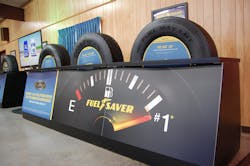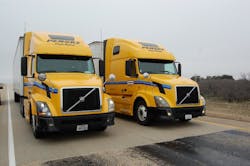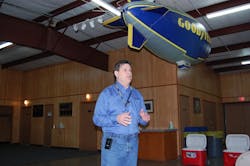SAN ANGELO, TX. Goodyear Tire & Rubber Co. said it will continue to focus on offering tires capable of delivering greater fuel savings to motor carriers as it introduced a new steer tire model to its Fuel Max truck tire line here at its proving grounds in West Texas, with two more additions on the way later this fall.
“Tires contribute 33% to long-haul fuel economy,” explained Brian Buckham, GM-product marketing for the Goodyear Commercial Tire Systems division, here during an event the company dubbed “Tire Technology Day.”“Based on our calculations, the break-even point between ‘fuel saving’ tires and ones designed for long tread wear is when the cost of diesel fuel gets down to $1.45 per gallon,” he noted. “And we don’t think we’ll ever see diesel go that low.”
That’s why Buckham (seen at right) said Goodyear is rolling out the Fuel Max LHS, a fuel-efficient long haul steer tire, to complement the Fuel Max LHD G505D drive tire launched last October.
He noted that the Fuel Max LHS offers 9% better tire tread life compared to its previous fuel-saving-specific steer model, as well as an 8% improvement in rolling resistance.
Later this fall, he said Goodyear will add a Fuel Max trailer tire and regional steer tire to broaden the fuel-saving potential of its Fuel Max design to all wheel positions on a tractor-trailer.
“We know that fuel is a long haul fleet’s number-one expense,” said Buckham stressed. “If you’re a fleet, the quickest way to reduce your operating cost is to reduce your fuel consumption.”
He also referenced a fuel expense calculation built on data points crafted by the American Transportation Research Institute (ATRI) and North American Council for Freight Efficiency (NACFE) to highlight such savings.
With fuel on average representing a 65 cent-per-mile cost for a trucking operation and the average on-highway truck traveling 119,000 miles per year, Buckham said, a fleet will spend on average $77,805 annually for one long-haul tractor.Based on those numbers, a 1% improvement in fuel economy translates into $778 worth of fuel savings per year per truck, he emphasized.
“And those savings accumulate rapidly, with a 2% improvement delivering $1,556 worth of savings and a 3% worth over $2,400 per year, etc.,” Buckham noted. “When you start talking about fleets that operate hundreds of trucks it really adds up.”
He also pointed out that Goodyear is planning to offer wider Fuel Max retread caps in April, adding 8-7/8-in. and 9-/4-in. caps to its existing 8.5-in. cap.
“The narrower retread widths represent the highest volume, which is why we came out with that first,” Buckham told Fleet Owner. “The wider widths we’ll be rolling out will provide an optimal fit for Fuel Max retreads on the tire casings in the market.”
Goodyear also showed off a new smart phone application during its tire event in San Angelo – one designed to minimize the hassles of transferring information during road call situations.
Gary Medalis, director of marketing for Goodyear Commercial Tire Systems, said that tire technicians typically must jot down detailed notes by hand while communicating to dealers, fleet customers and dispatchers by phone, which can open the door to mistakes and miscommunication, and create frustrating billing issues.
“Goodyear’s new Smart Tech App was developed to minimize these problems,” he said.
Officially rolled out at the Goodyear Dealer Conference in Dallas, TX, back in January, Medalis noted the Smart Tech App is available for both iPhones and Android smart phones and its designed to make the road service process easier for dealers and end users alike.“All necessary information – including the service call’s roll-time – is electronically and automatically sent to the customer,” Medalis (at right) explained. “There is no need for writing, memorization or phone calls, which saves valuable time and helps eliminate expensive errors.”
Also, via the Goodyear-Fleet HQ Tire Pix program, the Smart Tech App allows technicians to take photos of truck tires that were replaced, plus unit numbers and truck license plates. Those images are uploaded to a secure portal, where they can be viewed by customers, he pointed out.
He added that the Smart Tech App is one more element of Goodyear’s Total Package Solution, which is designed to help reduce fleet operating costs.
“We strongly encourage our dealers to download and use this dynamic new tool that will simplify the road service call process and help get trucks up and running faster and more efficiently,” Medalis noted.
About the Author
Sean Kilcarr
Editor in Chief
Sean Kilcarr is a former longtime FleetOwner senior editor who wrote for the publication from 2000 to 2018. He served as editor-in-chief from 2017 to 2018.



